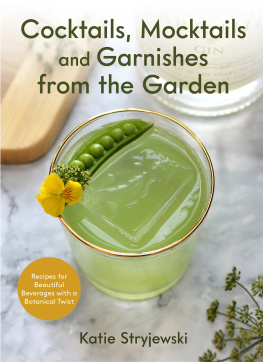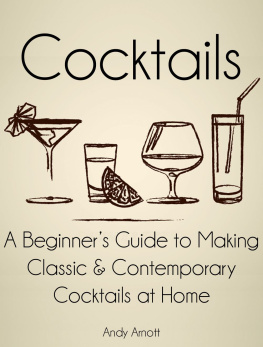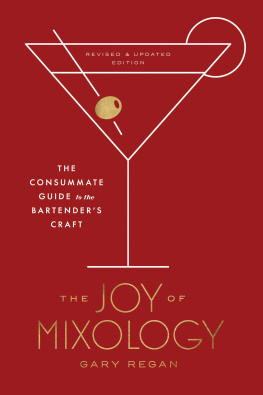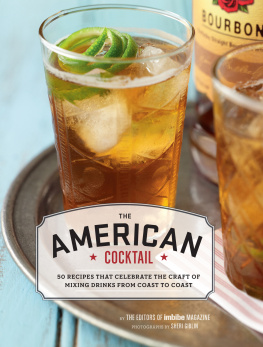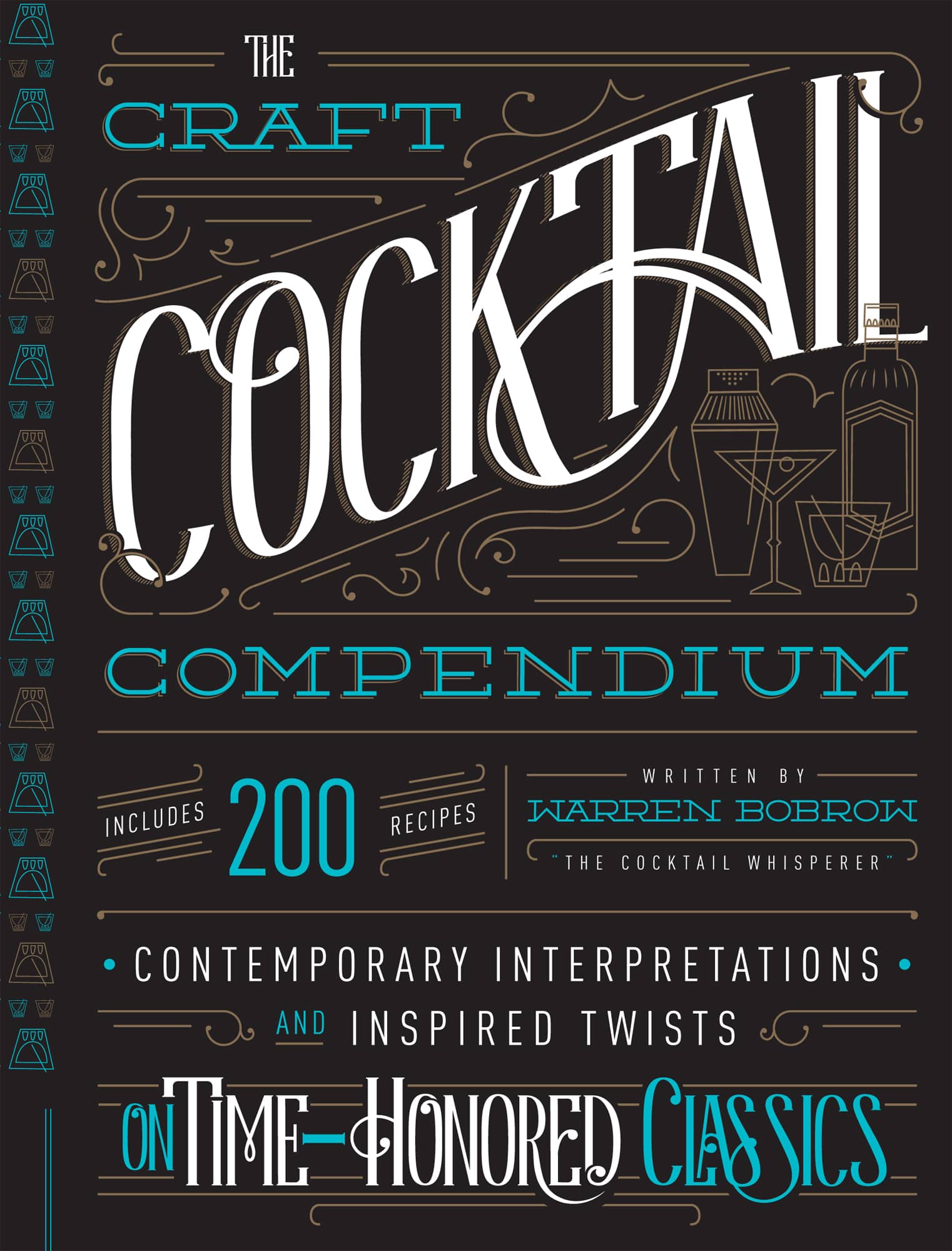Contents
Guide
INTRODUCTION
THESE DAYS, DRINKERS THE WORLD OVER HAVE AN EXCELLENT REASON TO LIFT THEIR GLASSES WITH GOOD CHEER. WHY? WELL, YOUD HAVE TO BE LIVING (AND DRINKING) UNDER A ROCK TO HAVE MISSED THE COCKTAIL RENAISSANCE THATS TAKEN THE TWENTY-FIRST CENTURY BY STORM. GONE ARE THE DAYS WHERE A COCKTAIL MEANT A HEFTY SLUG OF POOR-QUALITY BOOZE TOSSED OVER FREEZER-BURNT ICE AND TOPPED WITH A SUGARY, ADDITIVE-LADEN COLA OR RUBBISHY TONIC WATER. NO, SIR: DISCERNING DRINKERS PRIZE QUALITY OVER QUANTITY NOWADAYS, AND THAT ETHOS HAS SPREAD FAR AND WIDETO PROFESSIONAL MIXOLOGISTS AND HOME BARTENDERS ALIKE.
F irst of all, though, lets define our terms. In general, craft cocktails (and mocktails, too: alcohol-free cocktails dont have to be boring) value three things: top-quality spirits; fresh, often handmade mixers; and well-made ice thats hand-cut where possible. Do drinks made from these ingredients tend to take a little more time and effortand, perhaps, a little extra moneyto prepare? Sometimes. Are they worth it? Absolutely.
Enter The Craft Cocktail Compendium, a collection of nearly 200 cocktail recipes for every occasion. Theyre very different to one another, but they all have one thing in common: They take their inspiration from the history of mixology, a subject thats close to my heart. See, cocktails originated as medicinal cures that old-time pharmacists doled out to their customers long before the widespread production of synthetic drugs, and Ive been interested in the history of patent medicines and apothecaries for as long as I can remember. My grandfather was in the patent pharmaceutical business and, even as a child, the world of patent medicines and quack cures were a part of my day-to-day life. (In fact, they were impossible to ignore, since I was fed a teaspoon of spirit-based vitamin tonic along with my chewable vitamins and orange juice at breakfast every day.) Hence my fascination with, and passion for, the world of mixology.
Since cocktails were first created to be curatives, its no surprise that some of the recipes in this book draw inspiration from the apothecary. Back in the day, pharmacists would have used alcohol to preserve herbs healing properties and to prevent them from rotting. And said pharmacists would have administered these spirits along with, say, a little fizzy water and a final flourish of herb-laden bitters. There you have it: a template for the contemporary cocktail. These days, naturally, drinkers are more interested in the ingredients and the lore of apothecary-inspired cocktails, and dont necessarily visit cocktail bars to be cured of an illness. Instead, theyre enthralled by the histories of many older brands of liquors, some of which were originally created to be medicines or tonics. And they appreciate the use of herbal ingredients that would have been apothecary staples centuries ago. All of this reflects the fact that healthful, authentic eating and drinking are top priorities of twenty-first century tipplers.
Similarly, artisan spirits are experiencing a massive boom both in the United States and abroad. Small producers are creating truly exceptional handcrafted spirits, like gins, vodkas, and, of course, whiskies. (Purists, take note: If you think that theres only one way to drink whiskeyneat, no iceprepare to be astounded. Lots of the cocktails in this book provide delicious, artfully-created backdrops for the many varieties of American, Scotch, Irish, Japanese, and Indian whisk(e)ys that grace the market today.)
Whats more, this book will also show you how to make and use superior mixers, bitters, and garnishes for your drinks, since these are vital components of memorable cocktails. For instance, youll learn to make a variety of shrubs, which are flavorful mixtures of vinegar, sugar, and fruits or vegetables: their bright acidity and intense flavour profiles make them must-have ingredients for all your homemade drinks. Shrubs are easy to make, too; once you combine the ingredients, the natural fermentation that follows does all the hard work for you. And Ive also included recipes for homemade simple syrups, fruit pureesand even handmade bitters!to use in your drinks (and in the kitchen, too).
Whether youre after a mouthwatering aperitif, an old-fashioned curative taken straight from the apothecaries of yore, a cold-weather cocktail to warm your hands and lift your spirits, or the perfect drink to serve at your next party, youll find what youre looking for in the pages that follow. I hope you enjoy these handmade drinks as much as Ive enjoyed creating them.
APERITIFS:
CRAFT COCKTAILS TO WHET YOUR APPETITE
ONE CANNOT THINK WELL, LOVE WELL, SLEEP WELL, UNLESS ONE HAS DINED WELL, WROTE VIRGINIA WOOLF. SHE WAS RIGHTBUT SHE FORGOT ONE THING: ONE MUST DRINK WELL, TOO. AND THATS WHERE APERITIFS COME IN. A PERFECTLY-CRAFTED PRE-DINNER COCKTAIL CAN ACCOMPLISH WHAT NEARLY AMOUNTS TO MAGIC: IT CAN PREPARE YOUR PALATE (AND YOUR STOMACH) FOR AN EXCELLENT MEAL; IT CAN RESTORE DROOPING SPIRITS AFTER A LONG DAY AT THE OFFICE (AFTER ALL, YOU CANT ENJOY DINNER WHEN YOURE STRESSED OUT, CAN YOU?); AND ITS A GREAT POTABLE PARTNER FOR FINGER FOOD LIKE TAPAS, HORS OOEUVRES, OR OTHER NIBBLES.
A nd aperitifs have long been part of the fabulous food cultures of France and Italy, where diners might enjoy pastis or an Aperol spritz before a leisurely lunch or dinner. Historically, though, aperitifs werent created only to be pleasurable complements to food; they were also a way to administer medicinal herbs and spices that could ease the effects of the many belly-related maladies that plagued our ancestors before the age of refrigeration, such as indigestion and food poisoning. These valuable (and often expensive) botanicals were preserved in a suspension of alcohol, and the resulting liqueur would often have been bitter to the tastewhich is why so many aperitifs have such strong, bracing flavors. Other alcoholic tonics were created in days gone by in order to cure a specific ailment: for instance, Dubonnet, a type of quinine-laden vermouth, was developed by a French chemist and wine merchant of the same name in the mid-nineteenth century in order to combat malaria. But since quinines taste was so bitter, Monsieur Dubonnet concocted a secret recipe of botanicals to mask its flavor (its closely-guarded to this day), and voila!a popular pre-prandial tipple was born.
Want to get in on the action? Youve come to the right place. This chapter shows you how to make mouthwatering aperitifs that are sure to put you in the mood for food. Some are tried-and-true classics, like the Pretty-Close-to-Normal Manhattan shown : theres no better way to rouse a recalcitrant appetite, especially on a sultry summers evening.
Word to the wise, though: Be sensible when it comes to enjoying aperitifs, especially if youre planning on drinking alcohol with dinner, too. Stick to a single drink, or two at the most: theres no point giving that hangover a headstart.
A PRETTY-CLOSE-TO-NORMAL MANHATTAN
Since its a twentieth-century classic, youre probably already familiar with the Manhattan, at least in theory. Perhaps your mom drank one on the rocks every evening before dinner. Or maybe your beer-loving great-uncle used to mix himself a straight-up Manhattan once in awhile, on special occasions. Just like Mom and Great-Uncle Harold, the Manhattan is one of my favorite normal cocktails (for normal, read un-Cocktail-Whisperified). Its ingredients are as simple as could be, and its just as easy to prepare. Aside from the rye whiskey, theres nothing at all to add but bitters and sweet vermouthbut do feel free to play the field when it comes to the vermouth. Whichever way you craft your Manhattan, as long as you make it with rye whiskey, all will be well.


